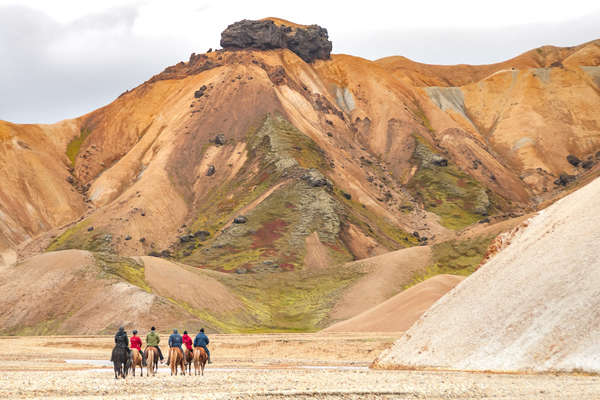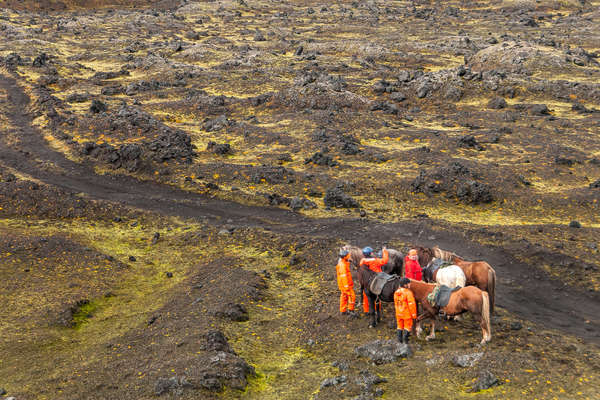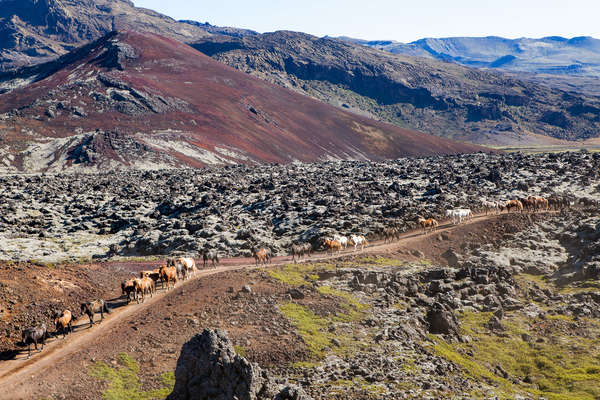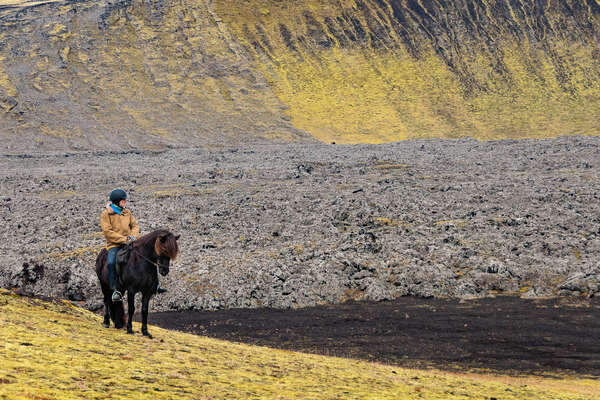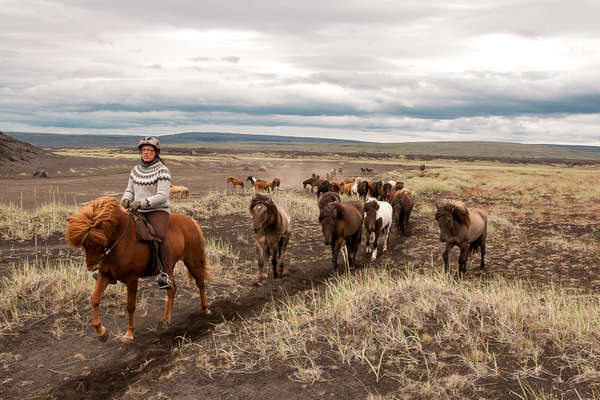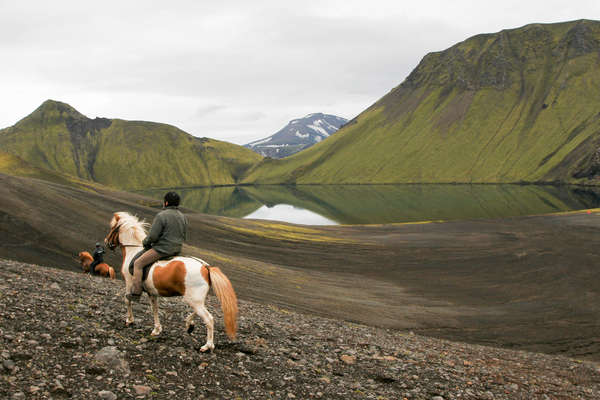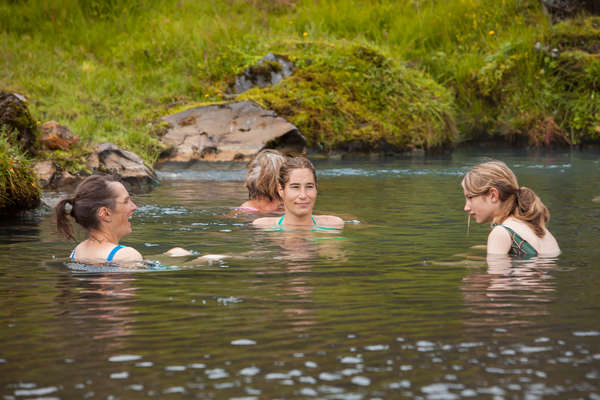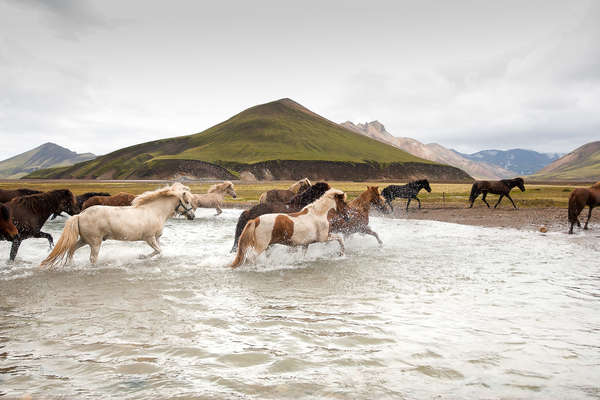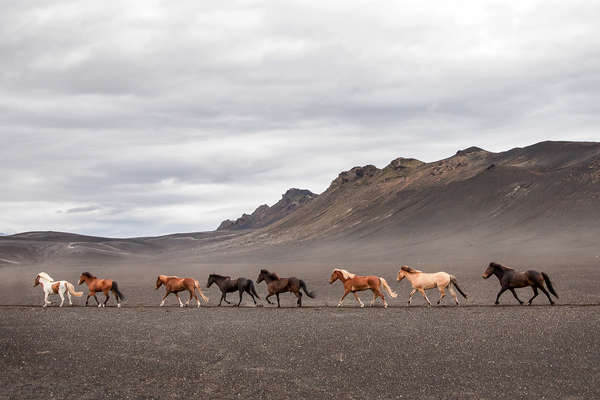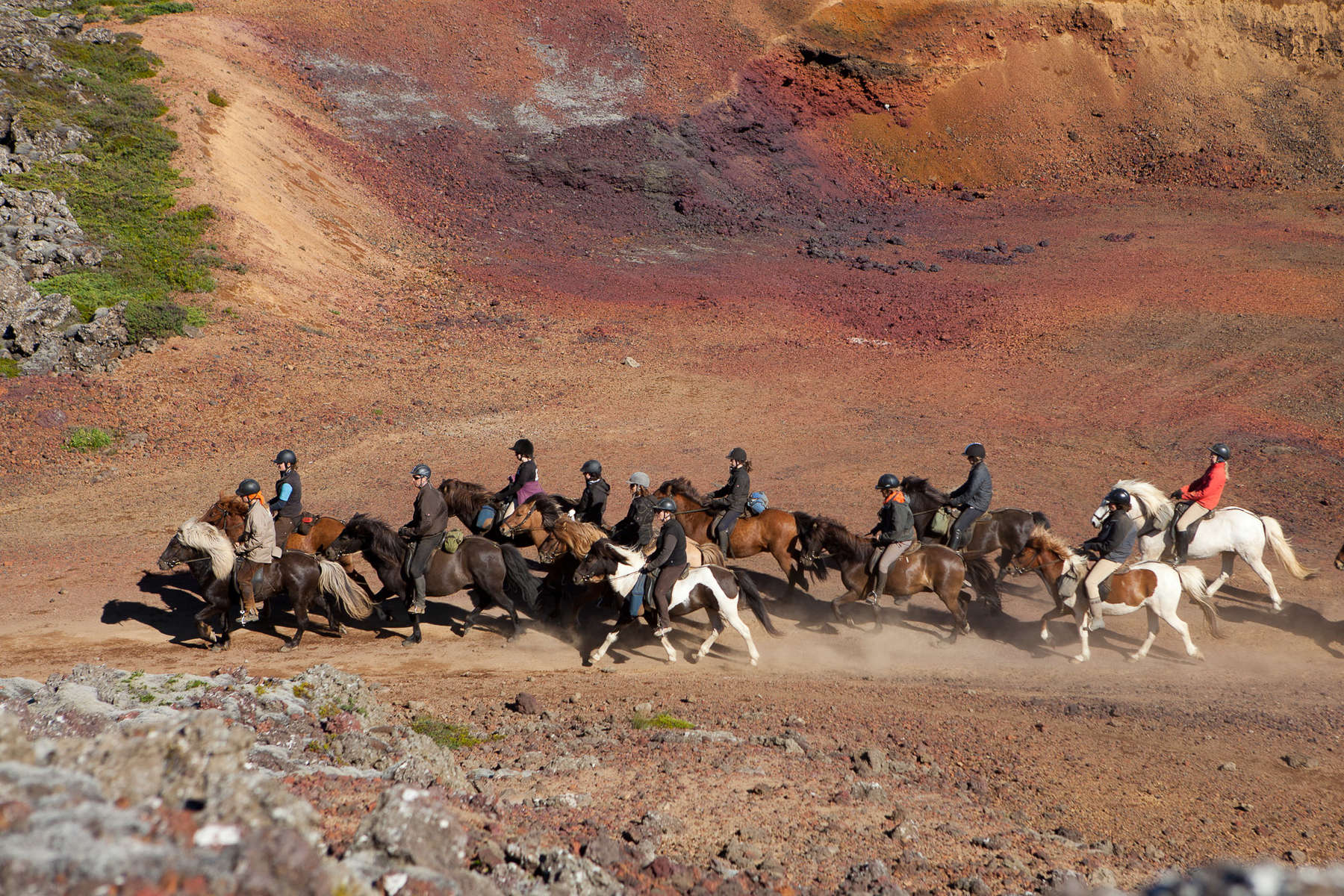
Itinerary
Highlights
- Swim in natural hot springs in the middle of a dramatic volcanic landscape
- Experience the unique and comfortable tölting gait of the Icelandic horse
- Ride through fields of ash, mountains and moss covered lava flows
- Stay in rustic and traditional accommodation
- Explore the countryside with an experienced and knowledgeable guide
- Ride close to the famous volcano Hekla (last erupted in 2000)
Dates & prices
Price details
- Flights to your destination are not included, but can be booked on request - please contact us for rates.
- Rates are per person, based on riders sharing communal rooms. There are no single rooms and you must be prepared to share.
- Transfers from Hella to Reykjavik return are included in 2021 and 2022
- Bus transfers to/from Reykjavik and the airport and hotel nights in Reykjavik are not included. See https://www.re.is/tour/flybus/ for more info on how to get from the airport to the city centre.
- There is a weight limit for this trip of 15st/ 209lbs/95kg
Please Note
The itinerary may be modified at anytime for security reasons, meteorological or events beyond our control such as blocked roads, rivers in flood, drought, strikes and local holidays. Equus Journeys, our local partners and their local guides will always strive to find the best solution and will alter the itinerary as needed.
The names of the hotels and accommodation are given for information only and depending on availability, they may be modified without notice and replaced by another of a similar standard.
Price includes
Support Team
1 Icelandic expedition leader
2-4 assistants in charge of the free-running herd
Logistics
1 vehicle and driver
1 cook
Inland transport
Transfer from Reykjavik city centre to Hella
Accommodation
Meals
Extra equipment
Price doesn't include
Meals
Dinner not included on day 7 - expect to spend around £28-36
Breakfast and lunch on days 1 and 8 are not included in the price. These meals are dependent on your flight times and may be had on the plane
Transport
International flights
Extras
Insurance
Optional
Accommodation
Equestrian info
Horses
Guide & local team
Minimum riding ability
Minimum riding ability
Pace
Tacking ability and participation
Trip conditions and Requested experience
Having previous experience of riding a trail of several days would be an advantage but it is not compulsory. Guests who do not ride regularly are requested to get fit prior to the ride. It is of particular importance to ensure you are comfortable and balanced when riding at speed across rough terrain and open spaces.
Equestrian equipment
Hard hats are mandatory. We recommend our riders to wear a helmet to the correct standard and you should bring your own to ensure a proper fit.
Travel info
Comfort
Please understand that accommodation in the highlands is always basic, with little privacy, small rooms and limited showers.
Meals
You prepare your own picnic lunch at breakfast time.
Vegetarian meals are available if requested when booking
Alcoholic beverages are not included in the tour price and are hard to get in the highlands. They can be bought at a reasonable price in the Duty-Free Store at Keflavik Airport upon arrival.
Climate
Tips
Packing list
Choosing to ride in Iceland is an incredible experience; however there are some important packing considerations for a riding holiday in this country. Icelandic horses have had no contact with other equine species and are not vaccinated. They do not have any resistance to diseases which are common elsewhere in the world and so it is important to take precautions to prevent the spread of infections.
- You MUST NOT take the following items into Iceland: saddles, bridles, halters, saddle pads, whips, brushes or any leather products which have been in contact with a horse.
- Your riding clothes must be thoroughly cleaned at least 5 days before departure (riding breeches, jumpers, coats, gloves) and should be washed in temperatures of at least 40°c.
- Items which cannot be washed at 40°c, such as riding hats or leather boots, must be thoroughly disinfected at least five days before departure:
1. Wash in detergent.
2. Dry thoroughly
3. Spray with a 1% solution of VirkonS detergent (10g per litre of water)
For more details please visit the Icelandic veterinary authority website: http://www.mast.is/english/frontpage/import-export/import/ridingequipment> information here
Head
- A riding helmet is compulsory and we recommend that you take your own to ensure a correct fit. Helmet makers (GPA, HKM, LAS Helmets, Lamicell, Troxel, Equithème) now offer horse-riding helmets that are ventilated, strong, light and comfortable.
- A flyhat to wear over your helmet may be a good idea in the summer months, when flies can be be an issue
- Sunhat for when not riding
- Sunglasses - with a cord attached so they don't fly off when riding
- Buff or bandana for protecting your neck and face from the sun, wind or rain
- Warm hat for cold evenings/days
Upper body
- Thermals in case of cold weather
- Long sleeved shirts provide protection from the sun or extra warmth
- Down jacket or gilet for cold evenings
- T-shirts
- Lightweight fleece or jumper
- Warm polar fleece or equivalent (plus a spare in case one gets wet)
- Waterproof jacket - rain can be difficult to predict and it's better to be prepared. In the mountains the weather can change quickly
Legs
- 2 pairs of lightweight, comfortable riding trousers or jodhpurs - we recommend riding in them at home before taking them on holiday to ensure they don't rub
- Waterproof over trousers
- Casual clothes for the evenings (jeans or walking trousers)
- Thermal trousers for cold days or for sleeping in
- A swimming costume may be useful for impromptu dips in the lake and washing in the river
- Non-irritant cotton or synthetic underwear
Hands and Feet
- Comfortable riding boots. We recommend short boots with half chaps but you may wish to take long chaps. We don't recommend taking your favourite long leather boots in case they get damaged
- Lightweight shoes or trainers for the evenings
- Sandals/flipflops
- Several pairs of warm socks
- Gloves - your hands are particularly exposed to the sun, wind or rain whilst riding
Nightwear
- Sleeping bags and possibly a sleeping bag liner (silk/cotton/fleece) adds extra comfort
- A small camping pillow
- Slippers (you will have to remove your shoes inside the accommodation)
- An eye mask can help with the 24 hour daylight
Our Recommendations
- Backpacks cannot be worn whilst riding. We recommend a small bumbag or a coat with pockets so that you can carry small items with you during the day (camera, sunscreen, lip balm etc)
- A soothing cream may be useful to treat areas irritated by long hours in the saddle
Other useful items
- Water bottle (1.5 litres or 2 equivalent)
- Headtorch or small torch for moving around at night - bring spare batteries and bulbs
- Toiletries
- Protein or cereal bars for the longer stretches of riding
- Toilet paper and a lighter to burn it after use
- Swiss army knife or equivalent (in checking-in luggage!!)
- Small plastic bags for you rubbish
- Ear plugs (may be useful)
- Camera and high capacity memory card. Spare battery
Personal medical kit
Make sure any allergies (to medication or otherwise) and clearly stated in your medical kit
- Any medication you regularly take
- Painkillers
- Imodium or similar anti-diarrhea medication
- Vitamin C tablets
- Sunscreen and lip balm - should be high factor
- Insect repellent
- Eye drops
- Hydrating/ soothing cream
- Plasters
- Blister plasters in case of any rubs
- Antiseptic cream, plasters, aspirin, anti-histamine, insect-bite salve etc..
- 10cm wide bandage
- Spare prescription glasses/contact lenses
- Re-hydration sachets
- Antiseptic wipes
- Handwash gel
General information
- Any liquids, such as shampoo, moisturiser, deodorant over 100 ml and all bottles can be decanted into small, clear, plastic Ziplock bags. We recommend biodegradable washing products where possible.
- We recommend taking a copy of your passport and insurance documents with you in case you lose your originals
- In your hand luggage carry any valuables, such as your camera, ipod, ipad etc.
- Travelling in your riding boots and carrying your hat and some riding clothes is highly recommended - then if your luggage goes astray you are still able to ride!
Sustainable tourism
- Travel light. It's a little known fact, but the lighter you pack, the better for the environment as heavy bags will produce higher emissions (when flying a plane or driving a car!).
- Reduce plastic waste. Take your favorite reusable bottle with you. Avoid single-use bags, cups, or straws.
- Preserve nature. Always take your rubbish with you during the ride and recycle them. Leave all the flowers or plants as you found them, and never get too close when observing wildlife. Make sure to use eco-friendly products such as body wash or laundry detergent (if camping) to protect both your skin and the environment.
- Choose your experiences carefully. Respect animal life by not participating in any activities that abuse wild animals (shows, elephant rides, etc.).
- Support local populations. Buy local handicrafts, be respectful of customs, and learn about the culture of local communities.
- Share! Raise awareness among your family and friends about sustainable tourism.
Did you know?
Did you know?
Mount
Hekla is one of Iceland's most prominent, well known and active volcanoes.
Standing at 1,491 metres high, it has frequent eruptions that start with an
explosive onset producing flumes followed by lava fountains and flows. Most of
the volcanoes flanks are covered by extensive lava flows from historical
eruptions dating back as far as 1104 AD. Its last eruption was in 2000.
Hekla
is part of a volcanic ridge which is 25 miles long and the most active part of
this ridge is a fissure of about 3.4 miles long called Heklugja. Mount Hekla
looks like an over-turned boat, with a series of craters along its keel, two of
which are the most active. This volcano has produced one of the largest volumes
of lava in the world in the last millennium, amounting to around 8 cubic
kilometres.
You
will ride through the lava fields and flows around Hekla on this trail ride in
Iceland before reaching the Landmannalaugar area.

